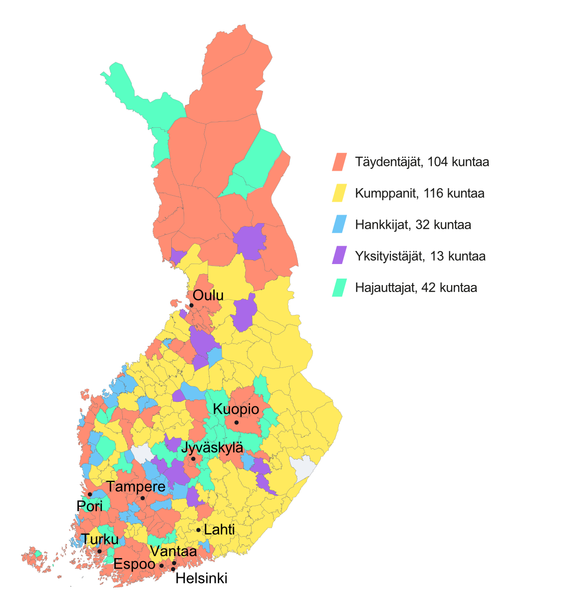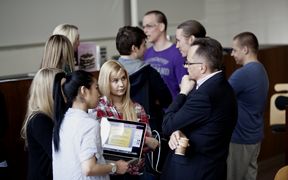Purchaser, Decentralizer or something else? This is how 309 municipalities in Finland have organised their social and health care services

A recent research shows that the tight polarization between public and private service provision does not match practice and privatisation of services does not automatically bring cost savings. Centralisation is worthwhile, however: Large municipalities and municipalities providing services through joint municipal authorities often have lower costs.
The research results and the practical experience of the costs of privatisation of social and health care services are contradictory.
For this reason, Aalto University School of Business professor Katri Kauppi and postdoctoral researcher Suvituulia Taponen from the University of Helsinki wanted to thoroughly examine how social and health care services are organised in practice in Finnish municipalities and how the costs differ between the production methods of different services. For the purposes of the research, they analysed how the production of ten different social and health care services had been organised in the 309 municipalities of Finland in 2016-2019 and whether the production method had a connection to the size of the municipality, population density and population structure or the costs of the services.
‘The research shows that no municipality relies on purely public or private provision of social and health care services. Instead, methods are combined and the same service can be produced in different ways,’ says Katri Kauppi.

Based on the analysis, Kauppi and Taponen divided the municipalities into five groups:
1. Collaborators (in the picture in Finnish "Kumppanit")
The municipality mainly procures the services from a joint municipal authority, typically approximately 95 per cent.
2. Supplementers ("Täydentäjät")
The municipality supplements its own service provision by purchasing services mainly from the private sector and other third parties. These municipalities buy, for example, on average 42 per cent of housing services for persons with disabilities and 43 per cent of special services for substance abuse from private or third sector. In this group, a lot of child protection services are purchased, approximately 72 per cent of the service production. The figures are averages of 2019 data.
3. Purchasers ("Hankkijat")
Purchasers are small municipalities with less than 20,000 inhabitants that are obliged by the act on municipal and service structure reform (169/2007) (in Finnish) to co-operate in service production. These municipalities purchase a significant proportion of their services from so-called host municipalities. Their production methods vary by service. In addition to their own production, the production methods include purchases from joint municipal authorities, other municipalities and companies.
4. Privatizers ("Yksityistäjät")
Very small municipalities produce few of their own services. They purchase a significant amount of their services from companies and partly from other public actors.
5. Decentralizers ("Hajauttajat")
In Decentralizers, production methods vary more than in other municipalities between individual production methods, and there is no clear dominant form. When examining long-term data, many municipalities moved either to or from the Decentralizers group. Decentralizers are likely to be municipalities in the transition phase, and decentralisation is part of an intermediate phase in which municipalities are moving from one of the first four models to another.
The research data was collected at the municipal level. For example, the data can show that a municipality bought 90 per cent of a certain service from a joint municipal authority. However, the data does not explain how the joint municipal authority had produced its service.
Cost differences smaller than expected
With the exception of Privatizers, service production in almost all municipalities relies on a combination of production methods. Municipalities flexibly combine public and private production, co-operate with other municipalities and purchase services from host municipalities.
Statistically significant differences in service production costs were found. However, the differences were not as significant as could be expected based on the contradictions in the public debate. In many services, Supplementers and Collaborators were able to show lower costs than others, but not in all services. In 2019, for example, the average cost per inhabitant of outpatient health care services was EUR 461 for Supplementers and EUR 486 for Collaborators, compared to EUR 569 for Decentralizers. The reason is likely to be the on average larger size of the Supplementer municipalities and the cost benefits of collaboration.
In addition to the production model, the differences in costs are also explained by age structure: On average, the population of Supplementers is younger than that of other municipalities. The most significant social welfare and health care costs were incurred by the Decentralizer municipalities, which can be explained by the possible costs and overlapping functions related to the transition phase of the service production.
‘The research results support the idea of cost-effectiveness of centralised services. When we compared the costs per citizen of different services, statistically most of the lower costs were found in Supplementers i.e. large municipalities, and in collaborators that had brought together the population volumes of several municipalities in a joint municipal authority. The cost-effectiveness of centralised services is one of the objectives of the wellbeing services counties starting on 1 January 2023,’ says Suvituulia Taponen.
The researchers emphasise that the new wellbeing services counties, especially those that do not have a joint municipal authority, will start operating in a transition phase. In this situation, service production may be at its most expensive. From the point of view of production costs, efforts should be made to move forward quickly towards an operating model of Supplementers or Collaborators.
Link to the research: https://www.tandfonline.com/doi/full/10.1080/14719037.2022.2150882
Further information:
Katri Kauppi
Professor
Aalto University School of Business
Department of Information and Service Management
Telephone +358 50 401 7112
katri.kauppi@aalto.fi
Suvituulia Taponen
Postdoctoral researcher
University of Helsinki
Faculty of Medicine
and Hankkinen Oy's founding partner
Telephone +358 40 762 9508
suvituulia.taponen@hankkinen.fi
Department of Information and Service Management
The Department of Information and Service Management refers to the creative use of information and digital technology in business and the move from industrial to service dominant forms of production.

Read more news
Growing Materials, Growing Ideas: Inside the Biomaker Studio
At Aalto University’s Biomaker Studio, initiated by Ena Naito, students and researchers experiment with living materials, from algae to mycelium, creating an open, interdisciplinary space where design, biology, and collaboration grow together.
Your voice gives away valuable personal information, so how do you keep that data safe?
With speech technologies becoming increasingly common, researchers want to make sure we don’t give away more information than we mean to.
Aalto in 2025: Quantum leaps, creative breakthroughs and solutions for a better life
Growth, technology and industrial renewal; human-centred solutions; health and everyday wellbeing; and enjoyable daily life and thriving communities.






